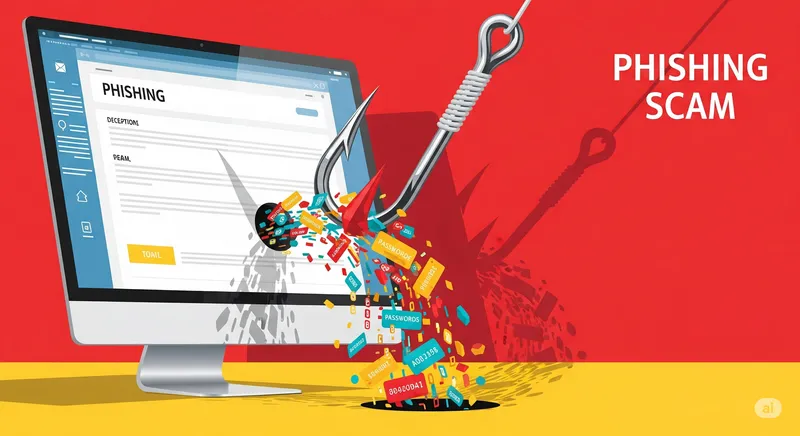Top 5 Phishing Scams to Avoid in 2025 (North County Edition)

You get an email. It looks official, maybe from SDG&E, your bank, or even a service like Netflix. It says there’s a problem with your account, your payment has been declined, or you’re owed a refund. It urges you to click a link and log in to fix the issue immediately.
This is the classic setup for a phishing scam, and in 2025, these attacks are more sophisticated and convincing than ever. Scammers are using AI and local information to craft messages that are incredibly difficult to spot. As the team that often deals with the aftermath—performing virus removal and securing accounts for residents in Oceanside and Encinitas—we see the devastating impact of these scams.
Here are the top five phishing scams we’re seeing target our North County neighbors, and how you can avoid falling for them.
1. The “Urgent Utility Bill” Scam (SDG&E / Water District)
How it works: You receive an email or text message that appears to be from San Diego Gas & Electric (SDG&E) or your local water district. It claims your last payment was missed and your service is scheduled for disconnection within hours. It provides a link to a convincing-looking payment portal.
Local Angle: Scammers know our local utility providers. They will use the correct logos and formatting, creating a powerful sense of panic. The urgency is designed to make you act before you think.
How to Avoid:
- Never click the link.
- Go directly to the official utility website by typing the address (e.g.,
sdge.com) into your browser yourself. - Log into your account there to check your real balance and payment status.
- No legitimate company will threaten immediate disconnection via an initial email.
2. The AI Voice “Family Emergency” Scam (Vishing)
How it works: This one is terrifying. You get a phone call, and it sounds exactly like a family member—a child, grandchild, or spouse. Using AI voice-cloning technology, the scammer creates a short, frantic message: “Mom? I’m in trouble, I’ve been in an accident and I need you to send money for bail/hospital bills.” The call then transfers to another scammer posing as a lawyer or doctor who demands payment via wire transfer, gift cards, or Zelle.
Local Angle: The caller might mention a local landmark like “I’m near the pier in Oceanside” or “I was on the I-5 near Encinitas” to make the story more believable.
How to Avoid:
- Hang up. Even if it sounds real.
- Call the family member back directly on their known phone number.
- Create a “safe word” with your family. If you’re ever in a real emergency, you can use this word to verify your identity.
3. The “Package Delivery Failure” Scam (Smishing)
How it works: You get a text message (this is called “smishing”) pretending to be from USPS, FedEx, or UPS. It says a package could not be delivered and you need to click a link to reschedule or provide your address. The link leads to a fake site that steals your personal information and credit card details under the guise of a small “re-delivery fee.”
Local Angle: With so many people in North County shopping online, this scam has a very high success rate.
How to Avoid:
- Legitimate delivery services will leave a physical notice (a “sorry we missed you” slip) on your door.
- Track your packages using the official tracking number on the carrier’s real website, not through a link in a text.
- The USPS will never text you to ask for personal details or payment.
4. The “Job Offer That’s Too Good to Be True” Scam
How it works: You see a posting for a remote job on a site like LinkedIn or Indeed. The pay is great, the hours are flexible. You apply, and you quickly get an “interview” via a chat app like Telegram or Signal. They “hire” you on the spot and then ask you to pay for your own equipment (like a new laptop) through their “preferred vendor,” promising you’ll be reimbursed. They send you a fake check to deposit, you buy the equipment, and days later, the check bounces. Your money is gone.
How to Avoid:
- Legitimate companies will never ask you to pay for your own equipment with your own money upfront.
- Insist on a video or phone interview. Scammers hide behind text chat.
- Be wary of checks. It can take a week or more for a bank to officially confirm a check is fraudulent.
5. The “Your Account is Locked” Tech Support Scam
How it works: An email from “Microsoft,” “Apple,” or “Geek Squad” claims your account has been compromised or your subscription has auto-renewed for a large amount ($499.99 is a common figure). To cancel or fix it, you must call a number. On the phone, the scammer will direct you to a website to “log in” or install a remote access tool, giving them full control of your computer to steal files and banking information.
| Red Flag | The Reality |
|---|---|
| Unsolicited tech support contact | Legitimate companies will never contact you first about a problem. |
| High-pressure tactics | They create urgency to prevent you from thinking clearly. |
| Request for remote access | Never give a stranger remote control of your PC. |
| Payment with gift cards | A 100% certain sign of a scam. |
If your computer is truly compromised or you suspect you have a virus, hang up the phone and bring it to a local, trusted professional. At PC Repair Center, we can safely remove any malicious software and secure your accounts.